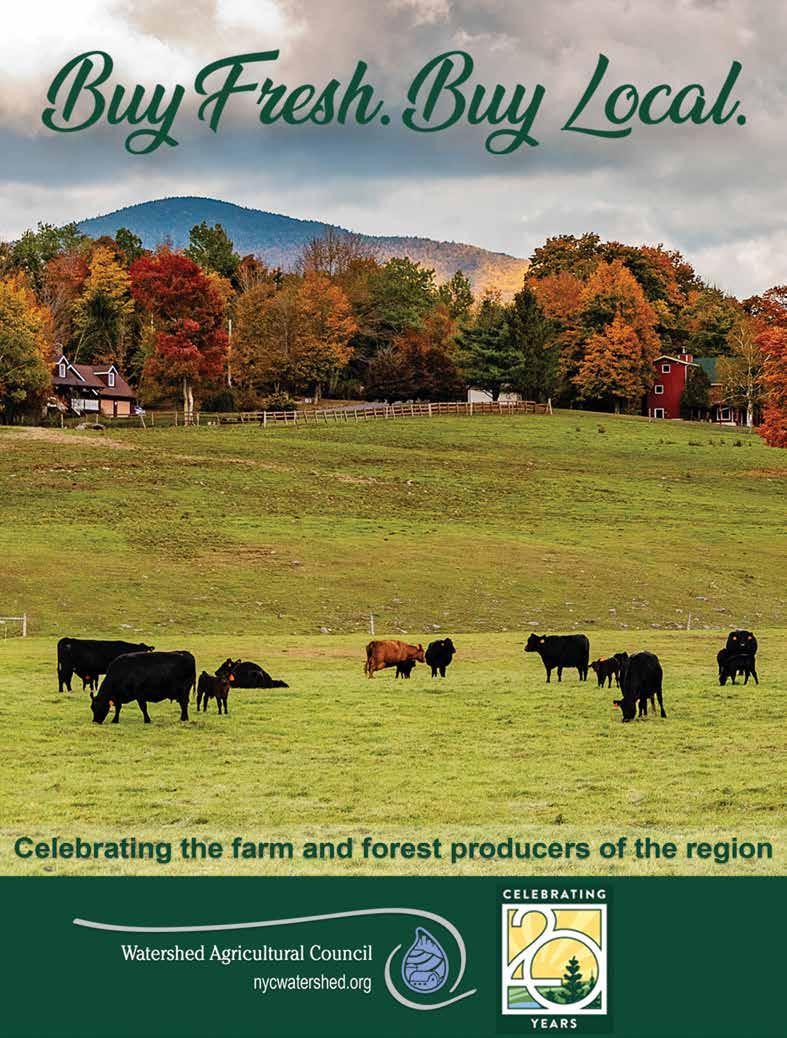
Culture & Community: stagecoach run art festival returns to treadwell
fun runs Deep at howe Caverns
athletes relish pickleball as sport surges
Garden of Weedin’: When in rome


Culture & Community: stagecoach run art festival returns to treadwell
fun runs Deep at howe Caverns
athletes relish pickleball as sport surges
Garden of Weedin’: When in rome
The Catskills are Home to Homemade Pasta





upstate life magazine, Winner, new york state associated press association first-place award for specialty publications, is published by:
The Daily Star, 102 Chestnut St., Oneonta, NY 13820 © 2024 - All rights reserved.
publisher Valerie Secor
editor Allison Collins
Graphic Designer Tracy Bender interested in advertising in upstate life magazine? Call toll-free, 1-800-721-1000, ext. 235
We invite you to email your comments to: upstatelifeeditor@thedailystar.com


Speaking with Phil Warish, organizer of the Stagecoach Run Art Festival, featured herein, he noted 20-year residents of the area saying things like, “I had no idea there was something like this here.” About a festival that’s nearing its 30th year.
On the one hand, comments like this must be frustrating for organizers of events whose mission is getting the word out. But on the other, I know this sentiment. As sleepy and unassuming as some of our upstate hamlets and villages can seem, it is also ceaselessly surprising how much you can find to do, right here at home, if you really look.
This edition gives a smattering of just such gems. Some, like Howe Caverns and Bramley Mountain, are more well known. Others, like Northern Farmhouse in Roscoe, offering handmade pasta in a scenic setting, or PLaY in Roxbury, a communitydriven space for yoga and growth of all kinds, are waiting to be discovered. And who doesn’t want to know more about pickleball? Even the dishes featured in my cooking column, created by the chef at Oneonta’s bside ballroom & supper club, take a familiar summer staple – corn – and make it feel fresh, unexplored.
I recently came across the Welsh word “hiraeth,” defined as “a homesickness for a home to which you cannot return, a home which maybe never was; the nostalgia, the yearning, the grief for the lost places of your past.” A sad word, yes, but a good one.
A BBC article notes, “A blend of homesickness, nostalgia and longing, ‘hiraeth’ is a pull on the heart that conveys a distinct feeling of missing something irretrievably lost.” I suspect, in our post-pandemic world, we all feel a bit of hiraeth. Summer itself, I think, smacks of hiraeth.
That post-pandemic longing has brought, too, a desire for increased connection and back-to-basics practices, and upstaters are rising to the occasion, devoting themselves to craft. To things meant to be enjoyed or tasted or experienced. So, as the region plays host to pockets of heavy seasonal tourism, the places and people in this edition are all about offering outlets: things to do and ways to connect, for those already at home, or those calling upstate home for just a little while.

If you go to Oneonta’s Neahwa Park any morning at 9 a.m. when the weather is good, you’ll see all eight pickleball courts in full use: 32 people playing doubles in teams of four. Some locals play pickleball seven days a week.
Becky Connolly has been playing pickleball for roughly 15 years.
“I learned how to play in Florida as a snowbird,” she said. “When I came home, I would drive to Richfield Springs on Tuesdays and Thursdays to play.”
Connolly saw a notice looking for pickleball or casual tennis play ers in the local newspaper.
“Inez Hymers wanted to start a group,” she said. “We used to chalk our lines and use the tennis courts in Wilber Park, initially. Then the city of Oneonta bought us portable nets.”
As interest in the sport grew, Oneonta officials agreed to convert the tennis courts in Neahwa Park to pickleball courts.
BY MONICA CALZOLARI
“It’s a really positive addition to Neahwa Park,” Maria McMullen, a retired middle school teacher for the Oneonta School District who has been playing pickleball for years, said.
There are two active groups in Oneonta that play yearround. The larger group, of which McMullen is a part, welcomes players at all levels.
“We are come one, come all. Everyone is welcome,” she said. “We come for fun and exercise. People are happy and pleasant.”

Connolly said, “If you are interested in playing or learning pickleball, just show up to the courts any morning and introduce yourself.”
There is another group catering to players at an intermediate level or above for more competitive play.
About 150 locals have joined “Oneonta Pickleball” through a nationwide application called Team Reach. Once you download the app, use the zip code 13820 as the password to join and receive notifications. Technology has brought together players from Oneonta, Delhi, Laurens, Cobleskill and beyond. McMullen noted that out-of-towners use the Team Reach app, too.
“When families visit the baseball camps over the summer, some come and play pickleball with us for a week,” she said. Connolly also maintains an email list of those interested in pickleball notifications. It contains the addresses of 100 to 150 people.
The pickleball community forges lasting friendships. And, McMullen noted, the sport offered people an option for play through the COVID-19 pandemic.
“During COVID, a lot of people set up nets in their driveways,” she said. “We socially distanced and it kept us
Colleen Brannan started playing pickleball right after retiring from the State University of New York at Oneonta three years ago. She started out as a beginner, playing at the local YMCA, indoors, during the winter. Then, she learned of the group that plays outdoors.
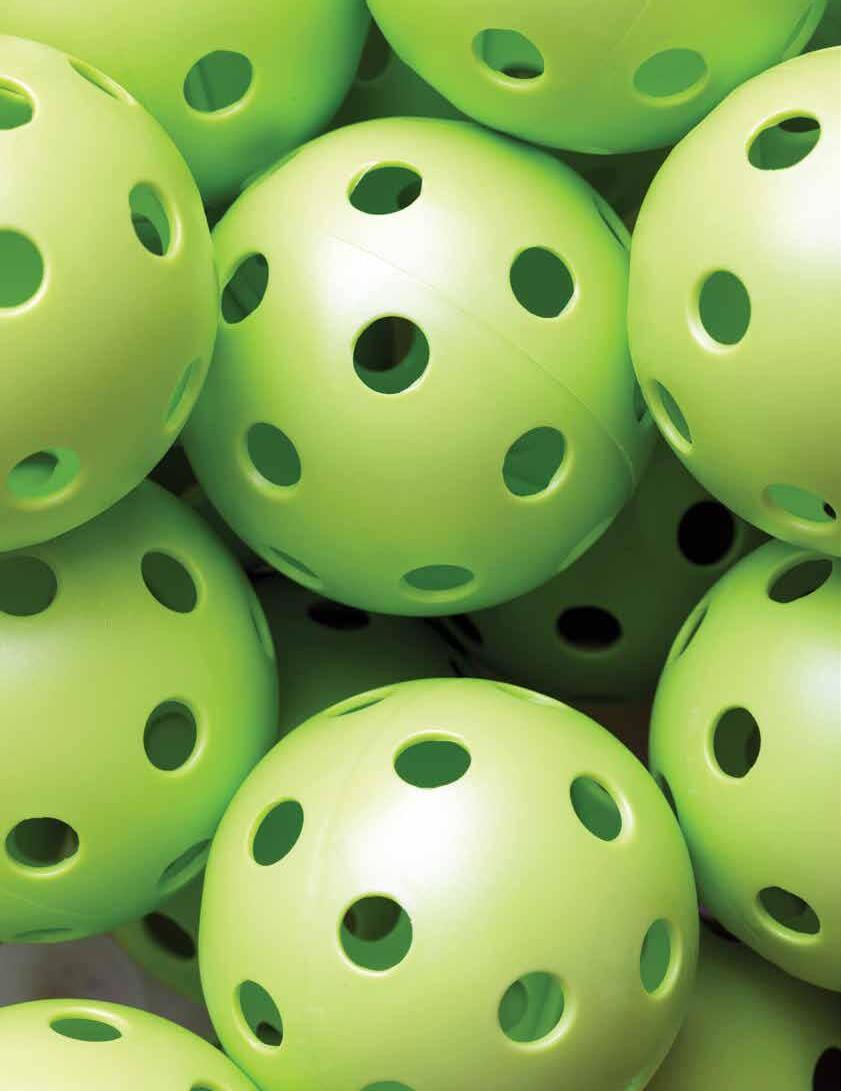


From top, clockwise: some members of the growing pickleball community gathered for a holiday party at sUnY oneonta, where this group plays pickleball indoors until the weather is nice enough to play outside. kim Back and sandy Jackson dress up for Halloween on the courts. Pickleball players volunteered their time to hold a clinic demonstrating to disabled children how to play the game. Pickleballers mary Drago and Becky Connolly in their Halloween costumes. Connolly wore her waitress uniform from Brooks’ BBQ, where she worked in the ‘70s. some of the participants at annual otsego Chamber of Commerce Pickleball tournament in 2023.
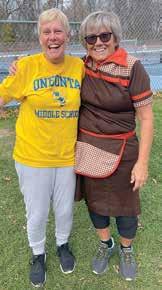


Participants can enjoy outdoor play at Neahwa Park or indoors at SUNY Oneonta’s Chase building, the OTC Sports Center and the YMCA, though the latter two are pay-to-play options.
SUNY Oneonta opens its gymnasium in the Chase building on Mondays, Wednesdays and Fridays from noon to 2, from fall until mid-May for indoor, free play. Players receive a special permit for free, on-campus parking.


“They have been incredibly welcoming,” she said. “Pickleball is my newest addiction. It is a great way to get exercise and be around positive people. You get to play with people who are at all different levels, and that’s the fun of it.”
Brannan even bought her grown children, in Rhode Island and South Carolina, pickleball She noted that some places, such as Charleston, have pickleball franchises requiring a fee to play. Oneonta’s offerings, she said, stand out for their accessibility.
“I am very grateful that it’s here,” she said. “We are very fortunate to have free play.”
When the courts are full, players hang up their paddles on the fence and wait until a spot becomes available. Most play doubles.
And, players said, Oneonta’s courts are hard to beat.
“Oneonta has the best outdoor courts within a one and onehalf hour drive from here,” Garrett Cole, of Cobleskill, said. Cole drives to Oneonta a couple times a month to play. Cobleskill has tennis courts, but no pickleball courts.
Terry Keister is part of the intermediate/advanced group and a lifelong athlete.
“I have always been competitive,” he said. “I have been playing pickleball since 2016. It starts out as a casual thing. As you get better, you want to play others who are at the same level. My wife calls it a cult.”
Garrett Cole called it “a game anyone can play.”
“I like the speed of it,” he said. “It keeps you engaged.”
Shamar Nicholson discovered pickleball when he lived in Oneonta and walked past the courts. Now, Nicholson commutes from Delhi.
“I did track, hockey, soccer and play recreational tennis,” he said,
IT’S A COmmuNITY. ThROugh PICklEBAll, WE hAvE mET mANY PEOPlE WE WOulD NOT hAvE kNOWN OThERWISE. WIN OR lOSE, IT DOESN’T mATTER; IT IS ABSOluTElY FuN.”
noting that the addition of pickleball was natural.
“Pickleball is not just for people who are retired,” Keister said. Elva Manee, another retired teacher, and Chuck Manee, are new to pickleball.
Chuck Manee played racquetball before undergoing two hip replacements and an ACL repair.
“Pickleball is fairly close to racquetball, which moves a whole lot quicker,” he said, noting that he’s lost 15 pounds playing pickleball six to seven days a week over two months. “It is good exercise, especially for aging people.”
Billy Erario said his wife got him started about one year ago and he’s been hooked ever since.
“It’s a community,” he said. “Through pickleball, we have met many people we would not have known otherwise. Win or lose, it doesn’t matter; it is absolutely fun.”
The Oneonta Pickleball Community has become a close-knit group, even celebrating Halloween, Christmas and the solar eclipse together.
Player Liz Hoheusle said, “We have an annual Pickleball Pizza Picnic. We play Pickleball Jeopardy. Usually, Kim Back is master of ceremonies. Mary Mancuso introduced the game. We have great laughs and sometimes we learn new things about the game.” +
Pickleball is the fastest-growing sport in the United States. It legitimized as a sport in 1972, when Pickleball, Inc. was founded. The game was started in 1965 by Joel Pritchard and Bill Bell in Washington. They invented the game as a pastime that their whole family could enjoy. They used ping pong paddles, wiffle balls and a badminton net. As they refined the game with the help of their friend, Barnet McCullum, rules for the new game emerged.
The Pritchard family dog was named Pickles. Legend has it that the dog liked to chase the ball while it was still in play. Pickles is one explanation for the odd name for this game.








BY mONICA CAlZOlARI
Tourists are finding one of New York’s biggest hits deep underground.
“Howe Caverns the second-most visited natural attraction in New York State, after Niagara Falls,” April Islip, general manager of Howe Caverns, said. Islip has worked for the Schoharie County tourist destination for the past 20 years. More than 16 million visitors have toured the caverns since Howe Caverns, Inc. reopened them in 1929.
Howe Caverns is open year-round and hosts approximately 120,000 visitors annually.
“Ours is the largest limestone cave in the Northeast United States which is open to the public,” Islip said. The caverns are just south of the Mohawk Valley near Cobleskill, off Route 88.
Howe Caverns is considered one of the best places to cool off upstate. The temperature deep underground is 52 degrees Fahrenheit year-round, with 70 to 75% humidity. Sweatshirts and long pants are recommended, as the atmosphere is cool and damp.
The cavern is named after a local dairy farmer, Lester Howe, who discovered the cavern in 1842. He noticed his cows liked to hover in the field near a bush on his neighbor’s property. According to legend, when Howe investigated, he found cool air coming from the ground and discovered an entrance to this underground cavern.
Islip said, in his discovery, Howe saw opportunity.
“Howe bought the property from his neighbor and friend, Henry Wetsel, for $100,” she said. Lester Howe explored the cavern for about a year before opening it up for tours to the public in 1843.
Those early tours were eight to 10 hours long, with participants carrying an oil lantern through the pitch-dark cavern. A lot has changed in the past 180 years. The most popular tour today lasts 90 minutes and is led by an experienced tour guide.
Visitors descend via elevator 156 feet, or the equivalent of 15 stories, below the earth’s surface. The traditional tour consists
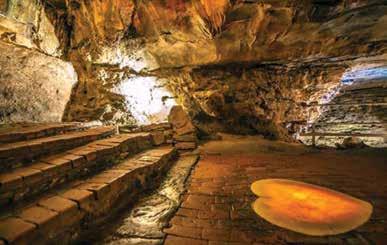
of a 1.25-mile walk with a .25-mile boat ride. There are also 139 stairs throughout the cave tour. The cavern is more than a mile long, so visitors are encouraged to wear comfortable walking shoes.
Explorers traverse walkways built between 1927 and 1929. They’re surrounded by beautiful stalagmites and stalactites in what is now a well-lit adventure. After the first half-mile by foot, the tour continues by boat for a quarter-mile round-trip ride on the Lake of Venus, named for its natural beauty.
The term stalactite means dripping, because the icicle-like formations are made as water drips from the roofs of limestone caves and hardens and builds up over time. Stalagmites are corresponding formations on the cave floor, with some of the largest given names, such as Henry the Turtle and the Leaning Tower of Pisa. Another resembles praying hands.
Water still drips from the caves’ ceiling. If you get wet, it is considered a “cave kiss” and a sign of good luck.


One of Lester Howe’s daughters was the first bride to be married inside Howe Caverns. Since then, 742 couples have tied the knot inside the cave. There is a limestone bridal altar and a back-lit, heart-shaped piece of limestone known as the glowing calcite heart.
According to legend, anyone who stands on this heart will be engaged within one year. Calcite is another name for limestone, and is formed by seashells and marine matter that fossilized on layers of bedrock.
Caverns have a series of rooms and Howe Caverns is no exception. It has a huge, open gallery named Titan’s Temple, which holds the largest and oldest limestone formations. Its ceilings soar 55 feet above the stream bed, creating a space reminiscent of a Chinese pagoda.
Another impressive stalagmite is named the Pipe Organ.
Over the years, the property has changed hands. During the Great Depression, it was sold to a cement company that made cement out of the limestone inside the cavern.
Local interest in reopening the cavern to the public resulted in Howe Caverns being incorporated in 1927. Making the cavern accessible to the general public required two years. The main lodge, the beautiful, Tudor-style structure that sits above the
COmE
caverns, houses a gift shop, cafe and historical exhibits and information.
According to the website, scientists believe Howe Caverns began forming some six million years ago. It is believed that the eastern part of New York State was underwater at the time, covered by an arm of the Atlantic Ocean. It took an estimated 400 million years to form the rock and several million more years of water erosion to form the caverns.
Water erosion created Howe Caverns. It is considered unusual to have a stream running inside a cave, but nature is still at work. Visitors can hear and feel drops of water continuing to shape the subterranean rock.
Richard Nethaway, the site’s longest employee, with more than 50 seasons, is the in-house historian.
“Come see what nature can do with water,” he said.
Some of this limestone is milky white. Mineral deposits within the calcium turn the rock different colors. Green rock reveals the presence of copper; yellow rock relates

to sulfur; and red rock contains minerals made up of iron and oxygen. Some of the limestone is translucent.
Limestone caves are one of the most common types of caves. The caves are natural cavities in limestone rocks and Upstate New York is rich in limestone. Limestone is a source of lime (calcium oxide) used in steel manufacturing, mining, paper production, water treatment and plastic production. Lime also has major applications in the manufacture of glass and in agriculture.
Built in 1958, the Howe Caverns Motel is a private 21-room motel that sells out. The motel is located across from the Main Lodge on the Howe Caverns Estate and is owned and operated by Howe Caverns, Inc. It overlooks the Helderberg Plateau.
The website advertises “rooms with a view,” because every room in the motel faces the picturesque valley.
Kids stay free with an adult in the motel, making the accommodations family-friendly. Several Facebook reviewers recommend the extra gem-mining activity for young guests. It is a smoke-free motel and no pets are allowed. There is an outdoor, seasonal pool on the property for motel guests.
Islip said, “Howe Caverns is a great, fun, historical place for families to come and visit.”
From left: more than 700 couples have been married within Howe Caverns. the backlit calcite heart at the foot of the bridal altar is pictured. stalactites hang from the ceiling of an underwater cave. the Pipe organ is an enormous collection of stalactites. Howe Caverns is accessible to the general public because of its elevator, lighting and walkways. a bride and groom stand on a pink calcite heart after tying the knot. | ContriBUteD


• Traditional Tour – a 90-minute, family-friendly tour
Specialty Tours
• Lantern Tour – romantic
• Flashlight Tour – a longer adventure tour, requiring rubber boots
Events
• Howe Fitness – Yoga, Zumba, Pilates in the cave
• Howe to Escape - Immersive escape room
• Weddings and engagements
Howe Caverns is open year-round: Wednesday through sunday, spring and summer Friday, saturday and sunday through winter
Closed Christmas and thanksgiving
note: not handicap accessible. no baby strollers allowed. no bags permitted on tours.
For more information: Howe Caverns 255 Discovery Drive
Howes Cave, nY 12092 (518) 296-8900
howecaverns.com “Howe Caverns” on Facebook +
From top, clockwise: mining for gems is a popular activity with children. You can purchase a bag of mining rough, and wash away the dirt in a trough of running water, revealing sparkling gems and minerals. a group of anonymous children is shown here. inside Howe Caverns, you’ll see large stalagmite formations with nicknames such as Praying Hands, left, and the leaning tower of Pisa. a boat ride is part of the 90-minute tour of Howe Caverns. | ContriBUteD


WATER STIll DRIPS FROm ThE CAvES’ CEIlINg. IF YOu gET WET, IT IS CONSIDERED A “CAvE kISS” AND A SIgN OF gOOD luCk.








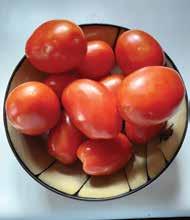

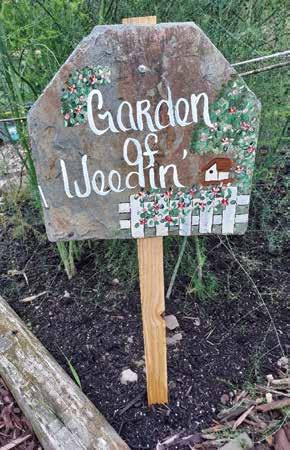
BY JOANNE ARBOgAST
Iused to steal jars of my dad’s spaghetti sauce because it was that good.
He let it go for a while, but when I started to get too greedy, he said, “You know, it’s a lot of hard work making that. Stop taking it.”
Hard work making spaghetti sauce? I didn’t believe him.
He also preferred his green beans big and fat and cooked soft. In due time, I developed a love of those, too.
Later, I learned those beans were called Roma beans and that the key ingredient in the sauce was Roma tomatoes. Both are staples in Italian cooking and, lucky for us, can be found fresh in local summer farmers’ markets, though only for a brief time.
But why buy when you can grow? Both do well in the garden and aren’t high maintenance. The only catch is, you need a lot of Roma tomatoes if you’re going to make sauce. And if you plant Roma beans, you are going to get a lot more than you may ever need.
Roma beans are also called Italian saucer or flat beans. Dad always referred to them as “fat beans,” but that’s probably because it’s the way he heard it. In any case, they are fat and they are flat.

Top left to right: the roma beans should be harvested when still tender. roma bean plants grow in arbogast’s ‘Garden of Weedin’’ in this undated photo. these egg-shaped beauties will be available in abundance this august at area farmers’ markets. or, if you’re lucky, your backyard. surplus roma beans make delicious dilly bean, perfect for munching alone or adding to a Bloody mary.
To grow them, you need to provide support. Plant the seeds next to a fence or trellis and train them to climb. Do that right away, because they grow fast. No joke, I have even seen them grow up a nearby tree, with the beans dangling from the branches.
Don’t dally when it comes to picking them. The beans get so big and heavy that, without support, they’ll end up laying on the ground, in puddles when it rains. Pick when they are still tender, before the inner seeds get too big. Because you eat the entire pod, you don’t want to bite down on hard pebbles inside.
Plant seeds in spurts until the end of July to keep those babies coming. They pretty much take care of themselves and don’t require much attention.
Yellow and green Romas are common but, if you’re lucky, you’ll find purple ones. After I’ve served up and frozen as many beans as I can stand, I jar up extras as spicy dilly beans. Just google a canning recipe that suits your purposes.
Brush twice, daily
In case you don’t know, Roma tomatoes are egg-shaped and also called plum or sauce tomatoes. They have a lower water content and thicker fruit walls than regular tomatoes. Every garden should have at least two tomato plants – one for big, fat slicing tomatoes and the other for cooking.

It’s been said that Italians have been eating them since the 1550s. That’s a long time to have perfected the art of making sauce.
Tomatoes belong to the nightshade family of plants, like potatoes and peppers. That means you don’t eat their leaves or stems. Some people don’t eat nightshades at all, claiming they can upset your gut. I don’t know about that, but I guess if you made a soup with tomato leaves and stems, your stomach would be in serious turmoil.
Here’s a funny tip I read about growing tomatoes: Brushing them lightly with your hand will encourage shorter, stockier plants. “The back-and-forth movement of the stem helps promote a hormone called cytokinin, which creates plants with thicker, stronger stems. This happens naturally when the wind gently blows them,” says “The Vegetable Gardener’s Bible,” by Edward C. Smith. I’d do that on the sly. Your neighbors might worry if they spot you petting your plants. +
Joanne Arbogast lives in Worcester with her husband, Fred, who won’t mind when the summer tomatoes and beans die off so he doesn’t have to have them with every meal.

When making squeezesauce, squeezing out the seeds in skins is one of the first steps.
Ultimately, the right way to get Dad’s spaghetti sauce was to help him make it. He gave me the recipe, which was actually his mother’s/my grandmother’s recipe, but I needed him to show me how to follow it.
So, several years ago, the two of us started making it together, in the middle of August when the Roma tomatoes are fresh and available in bulk.
Dad was right. It’s a long, tedious chore. First, there’s the squeezing the seeds and skins out of all those Romas and chopping up a load of onions and green peppers. The cooking process alone takes hours. But it’s worth it.
I don’t easily give away my jars of sauce either. I totally understand why Dad was so stingy.
if you’d like the recipe, go to thedailystar.com or email me at joannearbogast@yahoo.com and i will gladly share it. We’d like to hear your feedback.
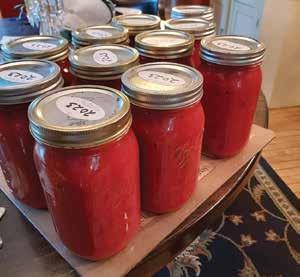

BY AllISON COllINS
Since the early ‘90s, the Stagecoach Run Art Festival has been turning Treadwell into an annual summer art hub.
This year’s festival, a walkable, self-guided tour of artists’ homes and spaces, will take place July 6 and 7. A preview show is happening in the Word & Image Gallery at Bright Hill Press & Literary Center of the Catskills, through July 6.
Nearly three decades from its start, the festival remains true to its roots, acting as, according to stagecoachrun.com, a “mission to forge and strengthen relationships between creatives and their neighbors while simultaneously demonstrating the financial and cultural value that artists add to a community.”
Jane Carr, founding festival organizer and Treadwell resident, said Stagecoach Run was conceptualized between herself and artist-neighbor, Joseph Kurhajec.
“It began because my neighbor Joseph had moved in in ’91, into Treadwell,” she said. “We got together and talked about art and the area and said, ‘Wouldn’t it be good if we started a festival that brought people into Treadwell and made Treadwell the place you can go to see art?’
“There are all kinds of places you can go to see dance or antiques or whatever, but there’s really no place that’s local that you can go
and see art,” Carr continued. “There’s MOMA and that kind of thing, but we wanted to bring art into our community.”
Carr, 85, said early festival planning fell to her and “about four other people in my dining room.” Carr noted that, though a Yaletrained sculptor, she “went back to egg tempera” after relocating upstate and “just loves it.”
“Joe had gone back to Paris, where he lives in winters, so I held this meeting and said, ‘Do you think we can do this?’ and everybody said, ‘Yes,’” she said. “That’s how it began. It just happened, because, when I moved here, I was an artist and met Joseph and, suddenly, I met six or eight other working artists right in the area, and they weren’t doing well and I wasn’t doing well. We all painted or sculpted or printed, but we didn’t have any outlet, so that was what we decided.”
Carr ran the festival for 16 years. Fellow artist and Franklin resident Phil Warish has been managing it for the past seven years, including the event’s revival following a pandemic-induced hiatus. Warish, a graphic designer, owns Blue Farm Antiques & Letterpress Printing in Franklin.
“I sort of became chair maybe seven years ago,” he said. “But we’ve been here 24 years and had a lot of friends that participated in the fest … and we went to as many as we could. So, when it came time for the last person that headed up the effort (to step down), it was a casual conversation that turned into, ‘Congratulations, you win.’ And I have a shop, so I have the space to exhibit in, and things came together.”
Festival planning, by a roughly seven-person committee, Warish noted, “starts maybe a month or two after the close of the last (festival).”
From “maybe 10 artists that lived in the area,” Carr said, the festival has grown to include more than 40 artists from diverse backgrounds and locales spread across 22 sites, all along the historic Catskill Turnpike. Carr noted that, in the festival’s fifth year, Franklin sites were added.
The festival format, organizers said, has kept it accessible.
“We do it well and it’s free,” Carr said. “You can come around and go to any of these studios – we have maps – and spend your money, or not, and just look at art. We had good brochures and we have it even better (now) and, I think because we did it every year and we put out posters, we just worked hard to get people in.
“It’s a very cheap fee (for vending artists),” she continued. “And I think it’s wonderful. The first four or five years, I had two collectors battling over my work and I made $7,000 in two days. I still make a good amount of money. I got 200 to 300 people through my little house (in 2023), and everybody else does. It started out just with studios and people’s houses, but now there’s quite a large space in the train museum in Franklin.”
“For participating artists, it is cheap,” Warish echoed. “It is very affordable; like $45 to participate, and I don’t care what street fair or event anyone participates in, that is a fraction of what anyone would ask, so it makes it very accessible for people. With this, as well as things like Franklin Stage Company and the West Kortright Centre and Bright Hill, it’s easy to dismiss these arts organizations as superfluous, but for a lot of people, on both sides of the fence – the artists and the vendors – it’s one of the reasons they’re in a place like this. Part of the (post-event) survey is (asking), ‘Did you have sales?’ and it’s anonymous, but sometimes they’ll say they made $50, but, last year, we had one respondent say she had about $14,000 in sales, off a two-day festival. And one of the things we encourage is demonstration – being hands-on and allowing people to be hands-on. They engage more easily and at a deeper level than if it’s just pinning stuff on the wall so, in that respect, it’s really an open-studio tour and that’s a model that has proven to work.


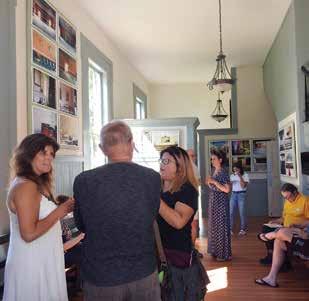
Festival organizers said Bright Hill Press & Literary Center of the Catskills, 94 Church St., Treadwell, has been a perennial Stagecoach Run supporter and collaborator but, new this year, the gallery will host a monthlong preview show of participating artworks.
“Bright Hill is doing a show of work that’s at the fest, from June to the festival date, so people can go in there and see it,” Carr said.
“They can see my piece on the wall and say, ‘Oh, I like her work, I’ll go to her studio’ or,
‘I don’t like that person’s work and I won’t go there,’ so it’s a really good thing to have at Bright Hill. Phil felt, ‘Hey, let’s give them a month to come in and look.’”
For more information on the Bright Hill Word & Image Gallery, visit brighthillpress. org.
AND IT IS A COmmuNITY EvENT. AS muCh AS PEOPlE mIghT SAY IT’S ABOuT SAlES, IT IS REAllY ABOuT REmOvINg BARRIERS FOR PEOPlE IN ThE COmmuNITY – WhEThER ThEY WERE FAmIlIAR WITh AN ARTIST BEFORE OR NOT. IT’S OPENINg ThE DOORS FOR PEOPlE AND gIvINg ThEm ACCESS.”


Artist Doug Jamieson has participated in the festival since relocating upstate in 2002.
Jamieson, a Treadwell resident, described his art as “a range of things.”
“What I’m showing is watercolors, oils and etchings,” he said. “half of my paintings are very traditional and the other half is this romantic surrealism. And the etchings are romantic surrealism. It’s interesting, I usually sell from each category.”
Jamieson, who worked previously as an illustrator and courtroom artist in New York City and taught at the visual School of Arts, is a veteran Stagecoach vendor.
“I came up here as a professional, thinking it was about time to retire, and I never retired,” he said. “I’m working like mad; I just make my own stuff and don’t have to answer to anybody.
“I bought the house and didn’t have any idea there were a whole bunch of artists around or that it was an artist community,” Jamieson continued. “The first time I did (the festival), it was in the fall – the only time they did Stagecoach in the fall – and I didn’t take it too seriously; I put a bunch of stuff on the wall with pushpins … but hundreds of people came. I’ve been doing it since

then, in July, and, last year, I got 269 people through the house over the weekend, so it’s quite a good experience and I did get some sales. I’ve hosted people in my yard, and my bottom floor, five rooms, is full of my art.”
Jamieson noted that he’s seen artist and attendee demographics shift, but said that’s part of the appeal.
“Typically, artists are busy showing, so it’s not really that local, but people come from all over the place,” he said. “And it’s interesting that it’s not a uniform group of people; there are people doing traditional things and edgy things and ceramics and woodwork and so on, so it’s a wide range of things. So, when people come, there’s actually something for everyone. If you don’t like modern art, there’s traditional landscapes, and if you can’t find that, you’ll find wacky, edgy surrealism somewhere else. And people seem to like going into people’s houses and studios; I get as much response to my old house as my art. It’s a good experience when people like what you do and you get positive responses.”
For more information on Jamieson’s work, visit dougjamiesonartist.com.
For a complete list of this year’s Stagecoach artists, visit stagecoachrun.com.
“And it is a community event,” he continued. “As much as people might say it’s about sales, it is really about removing barriers for people in the community –whether they were familiar with an artist before or not. It’s opening the doors for people and giving them access.”
Such factors, organizers said, drove the festival’s return following the COVID-19 pandemic.
“I think people were dying to have it back,” Carr said. “It’s one of the biggest things going on.”
“For the entirety of 2021and ’22, we were fielding question after question of, ‘When is it coming back?’,” Warish said. “And we wanted it to; the core group of organizers really wanted to see it back, and last year was a little cuckoo.”
And, sources said, Stagecoach’s return coincided with shifting patron demographics.
“(In the) followup survey, (asking), ‘How many people did you have visit, how were your sales, how many people were new to the festival?’ what we realized was, there is a completely new audience here compared to 2019,” Warish said. “A Sunday for the festival used to be the quiet day and the day that people could leave their own studios and go see somebody else … but we were keeping count and the count on Sunday was higher (in 2023) than on Saturday, and it was a total of like 450 people over the course of the weekend. It varies across locations, but I was like, ‘Wow, that is a pretty high number.’ It was great; we didn’t know what was going to happen … but it felt great that there was that much of a turnout.”
“As the western Catskills has seen a huge influx of newcomers since the pandemic,” stagecoachrun.com states, “(the festival) mission seems even more relevant and important.”
And, Warish noted, committee members distribute roughly 4,000 brochure maps “across the area (to) business and arts organizations” in the leadup to the event.
“We go as far as Margaretville, and down to Binghamton and as far north as Springfield,” he said. “We try to organize people who are participating in the festival to get some help; it’s the tradeoff we can make for making this cheap, but you’ve got to help us get the word out.”
For more information, visit stagecoachrun.com or follow @stagecoachrunartfestival on Instagram. +

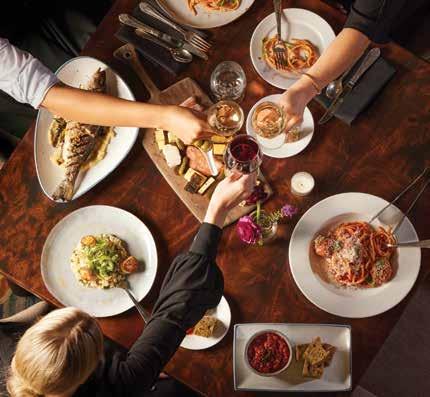


Relax in Montgomery’s only rooftop pool and spa. Escape to the elegance of Mobile’s historic Battle House Hotel. Come experience Alabama’s top hotels, resorts, and courses along the Robert Trent Jones Golf Trail. Stay in eight luxury hotels and play 26 world-class courses from the Tennessee River to Mobile Bay. Laugh, play, explore, and relax in picturesque settings. Pamper yourself in luxury spas. Tee off with family and friends. Walk to area attractions. Enjoy farm-to-table cuisine. It’s time to plan your next trip to the Robert Trent Jones Golf Trail. To learn more, visit rtjgolf.com or call 800.949.4444. We will be here awaiting your arrival.




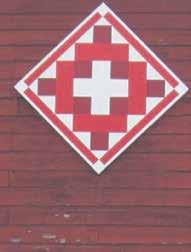
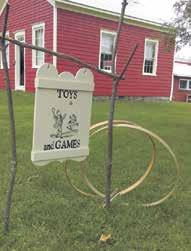
























































BY lEIgh INFIElD
For years, Italian families have gathered around the table to enjoy pasta, often home-made by Nonna (Italian for grandmother) from a generations-old recipe. In Italy, pasta is more than just a meal; it’s part of the culture.
The art of kneading the fresh dough and cutting it into shapes is a skill handed down from one generation to another and sitting down to share it with family and friends has become a tradition woven into Italian life. It is a tradition that is alive and thriving in the Catskills, where you will find pasta, lovingly made by hand, served up in style.
OuR kIDS’ FRIENDS WOulD COmE OvER TO OuR hOuSE, AlWAYS ASkINg FOR mR. PIZZO’S PASTA.
FOR A COuPlES’ NIghT OuT, NEIghBORS WOulD OPT TO DINE AT OuR hOuSE, INSTEAD OF gOINg TO A RESTAuRANT. ThEY lOvED JAmES’ PASTA.”
For James Pizzo, chef and owner of Pizzo’s Pasta & Gourmet Foods in Delhi, the making of pasta has been a family affair since his grandparents immigrated to Brooklyn from the small town of Nola, outside of Naples, Italy. He remembers growing up in Queens, helping his mother make pasta just like Nona’s.
As a 6-year-old, James would help knead and roll out the dough, cut it and put it on hangers to dry, then work it into different shapes. He’d cut parsley, chop garlic and grate cheese for the sauces his mother made from time-honored family recipes as rich flavors filled the kitchen.
At Pizzo Pasta & Gourmet Foods, James carries on the family tradition. A dine-in, take-out trattoria and gourmet market, Pizzo’s menu has more than two dozen specialty entrees, served over fresh, homemade pasta. Many of these recipes have been handed down from James’ grandmother and mother, while his father taught him to make the seafood specialties, his favorite being linguine with red or white clam sauce.
Mornings find James in the kitchen getting ready for the day – rolling out pasta dough, starting the sauces, selecting ingredients for a special, or preparing his famous Italian subs. His British-born wife, Roslyn, a culinary arts graduate, can be found preparing one of her signature Italian desserts (customers have been known to travel miles for her blueberry bread pudding), or assisting in the pasta prep. Her balsamic dressing is also renowned. Their 14 year-old daughter is also passionate about pasta, and enjoys helping out after school or on weekends.
The road to owning their own restaurant started when the couple moved to Florida.
“Our kids’ friends would come over to our house, always asking for Mr. Pizzo’s pasta,” Roslyn said. “For a couples’ night out, neighbors would opt to dine at our house, instead of going to a restaurant. They loved James’ pasta. He would volunteer to cook for friends’ special events – birthdays, communions and anniversaries. We looked at each other and said, ‘We should open a restaurant.’”



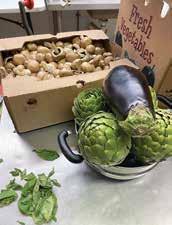
Their first restaurant in Vero Beach was a success. With a seating capacity of 70 and a special event room that could accommodate 100 guests, it kept them on the go. Plus, they operated two delis. At night, Rozlyn, completed a course in culinary arts and began joining James in the restaurant. Their son, 10 at the time, helped Dad build the oven, brick by brick. Opting for a more leisurely pace, they relocated to the Delhi-Margaretville area, where James had enjoyed hunting and staying at his uncle’s cabin.
Not ones to retire, the Pizzos began bottling James’ sauces and packaging their pasta to sell at Delhi’s outdoor markets. They briefly operated a popular take-out and delivery business in Andes, while their new space in Delhi underwent renovations.
Diners could take out or have delivered such specialties as chicken marsala, Osso buco, shrimp scampi, fettucine with clam sauce, veal piccata and ravioli and lasagna – all freshly made – from Pizzo Pasta, and word spread quickly.
“James is all about the food,” Rozlyn said, noting that every dish is created with love and care, using ingredients sourced locally. Seafood is brought in fresh from a seafood market in the Bronx. Served in their cozy, comfortable trattoria with a deli section and a small space for outdoor dining, Pizzo Pasta carries on the centuries-old tradition of sharing great Italian food with its customers.
Dine in, order takeout or bring home one of their ready-to-serve entrees. Shoppers can buy their bottled sauces and fresh pasta at the trattoria or Delhi’s Wednesday market on the square. Pizzo Pasta will also cater your next event. The trattoria, 191 Main St., Delhi, is open daily from 7:30 a.m., serving some breakfast items, to 9 p.m. Email pizzosgourmetfoods@gmail.com, visit pizzosgourmetfoods.com, call 607-206-0710 or follow them on Facebook for more information.
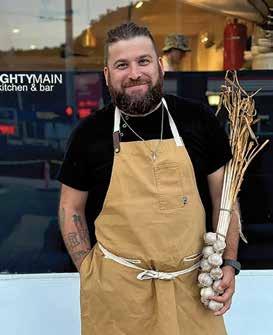
ThERE ARE NO SECRETS AT OuR RESTAuRANT. EvERYThINg, FROm APPETIZERS, PASTA DIShES TO ENTREES, IS mADE IN ThE STOREFRONT kITChEN RIghT BEFORE YOuR EYES.”

Walk down Main Street in Delhi on an evening and you’ll pass a mesmerizing storefront window: Steam rises from a commercial stove while guys in big hats prepare plates of homemade pasta topped with tempting sauces. Something special is happening at the Italian eatery and wine bar known as EIGHTYMAIN KITCHEN & BAR.

“Frederico Fellini once wrote ‘Life is a combination of magic and pasta,” Brooklyn-born chef and owner, Will Johnson, said. “By positioning our kitchen at the front of the restaurant with a large window that opens onto the sidewalk, people passing by can get a glimpse of that magic.” His restaurant and bar will celebrate two years in business this Fourth of July.
“There are no secrets at our restaurant,” Johnson said. “Everything, from appetizers, pasta dishes to entrees, is made in the storefront kitchen right before your eyes.”
EIGHTYMAIN KITCHEN & BAR can produce 55 pounds of pasta per hour, in 12 extruded shapes. Lasagna, ravioli and barchette – little pasta sailboats with fillings such as ricotta cheese, peas and mushrooms – are made by hand. Fresh, homemade pasta can be purchased at the restaurant or enjoyed at a sit-down meal.
“Watching food made in the window has become a big attraction,” Johnson said. “Passersby see plenty of action.” Chef Johnson’s dishes blend Northern Italian with Argentinian cuisine.
“In opening an Italian restaurant, we wanted to take a different approach,” Johnson, whose Italian heritage comes from his Sicilian grandparents, said. “Argentina has a connection with our area in that both are known for wine, dairy and beef. This similarity allows us to combine the two, adding a different, elevated dimension to traditional Italian cuisine.”
Johnson’s partner in the business is his brother-in-law, James Arrufat. As the restaurant’s main bartender, visitors will often find him behind the cedar bar, where distinctive wines and liqueurs, several locally made and selected by Arrufat, are available.
Ingredients FOR EIGHTYMAIN’S dishes are sourced locally.
“We have developed strong relationships with local farmers and offer our customers the freshest produce,” Johnson said. “Our food is prepared with care, but also raised, grown and harvested by people who really care about what they are doing. I’d comfortably say that, in peak season, 90% of our produce comes from farms within 35 miles from us.”
Johnson began in the restaurant business at 17, when he participated in a special public-school program called Careers through Culinary Arts.
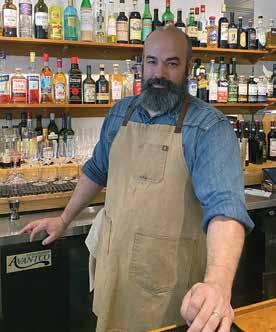
During a gala event, students were paired with a chef. Johnson was paired with Michael White. After graduation, he looked up White, waiting outside his restaurant to ask for a job.
“I asked if he remembered me and he said, ‘No,’ but ushered me down to the restaurant’s basement, where I went to work,” he said. “You might say I started in the industry from the ground up.”
Johnson worked for White on and off for four years in three separate locations. Then came stints in Nantucket and Boston, where he took his first leadership management role in a kitchen. In Chicago, he helped open a new concept hotel and restaurant. Then, in Florida, he helped open four restaurants as part of a hospitality management group.
Johnson left the corporate restaurant business, feeling it was time to do something more personal. It took him three visits in a month to know that the Catskills would be home to the next chapter in his career. His sisters had been coming up to the area since childhood and his aunt had lived locally for 40 years. Being near his family in Delhi was a strong draw for Johnson. Initially, he formed the Catskill Pasta Company, selling fresh pastas and sauces at area farmers’ markets until the opportunity arose to purchase his own brick-and-mortar restaurant.
EIGHTYMAIN has become home to Johnson; everything within its four walls has a story to it, from the choice of wood to the colors. The interior is inviting and filled with light. White walls offset the cedar bar located on one side of the room, and tables are set with small bouquets of fresh flowers. Taking care of people by making sure they feel comfortable and welcome, while enjoying a memorable meal, is EIGHTYMAIN’S forte.
Johnson is passionate about food and feels that it is what unites every culture.
“Each culture has its music or art, but also there’s no culture out there where people don’t share food,” he said. “We have been fortunate to have a community that supports us and customers who want to take the journey with us.”
EIGHTYMAIN KITCHEN & BAR, at the crossroad of Route 28 and Main Street in Delhi, is open from 5 p.m. to 9 p.m., Thursday through Monday; 5 to 10, Saturday; and 5 to 9, Sunday.
For reservations, visit eightymain.com or call 607-464-4043. Follow @ chefwillateightymain on Instagram.

Mornings in Roscoe, travelers might just spot chef Robert Eckert, bicycling to his 200-year-old red farmhouse, also in Roscoe, where he begins the day by turning out homemade pasta. Chef Eckert’s restaurant, Northern Farmhouse Pasta, is known as the first and only restaurant in New York to make fresh pasta from locally grown and milled wheat flour.
Cited by ‘I Love New York’ for three consecutive years as one of the 11 best restaurants in the state serving fresh pasta, Northern Farmhouse offers a farm-to-table menu of homemade Italian pasta dishes along with Asian-inspired ramen. Diners can enjoy artisanal pastas, specialty seafood dishes such as Polpo alla Luciana (a Naples stew of chopped octopus), or garlic chicken, pork and curry shrimp ramen noodle bowls, all served in a cozy rustic setting.
Little did Eckert, growing up in Jamaica Bay, Queens, foresee that he would own a restaurant in the Catskills. His family was originally from Naples. Many of the Italian dishes, like his Pasta a la Genovese, are prepared in the traditional way. This dish incorporates lamb, onion and fresh spinach, many of which are sourced locally.
The 100% wheat flour Eckert favors comes from the Finger Lakes region and Lucky Dog Farm in Hamden. The wheat is ground at Farmers Ground Flour, a mill in Trumansburg, New York, outside of Ithaca.
It wasn’t until Eckert met his wife Jen, who lived in Roscoe, that he left Manhattan, having built 31 high-rises in the city over time. The couple married and based themselves in Roscoe, where Eckert, on a whim, started to make pasta to sell at local markets.
“The first day I sold seven boxes of ravioli and 10 bags of pasta,” he said. “I thought it was wonderful. I was left thinking, ‘I just made something people want to eat.’”
In 2014, Eckert started making pasta commercially in one of the oldest buildings in Roscoe – the historic red farmhouse he purchased on Rockland Road. Three years later, 2017 marked his busiest year yet, selling 22,000 boxes of ravioli and 70,000 bags of dried pasta. By 2018, his restaurant business took off. He stopped selling wholesale to focus on making creative dishes, realizing that many of the traditional Italian dishes had gotten lost. He began to add his own touches to time-tested favorites.
Eckert and his wife support each other in their business.
“Jen is the pedestal that holds me up,” Eckert said. “She handles the business end of it and lets me cook. Her sister, Melissa, works with me full time in the restaurant. We are truly family-run.”
Northern Farmhouse Pasta is at 65 Rockland Road, Rosco and is open from 4 p.m. to 9 p.m., Thursday and Friday; and noon to 9, Saturday and Sunday.
Call for reservations: 607-290-4064, email northernfarmhousepasta@gmail.com or visit northernfarmhousepasta.com. +
ThE FIRST DAY I SOlD SEvEN BOxES OF RAvIOlI AND 10 BAgS OF PASTA. I ThOughT IT WAS WONDERFul. I WAS lEFT ThINkINg, ‘I JuST mADE SOmEThINg PEOPlE WANT TO EAT.’”


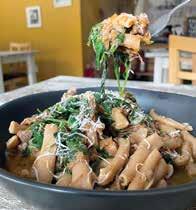

For much of the 20th century, a network of fire towers and fire observers in the Catskill and Adirondack mountains served to protect forests and communities from devastating wildfires.
In the early 1970s, New York State started using air surveillance instead and began closing fire towers, with the last ceasing operation around 1990. Recently, there has been a revitalization of fire towers in the area, with community interest and engagement allowing towers to stay open to the public or, in the case of the Bramley Mountain Fire Tower in Delhi, to rebuild the fire tower itself.
Bramley Mountain Trail was created by the Catskill Mountain Club in 2014, becoming a community favorite over the years, especially during the COVID-19 pandemic, when trail usage skyrocketed. With four miles of trails, including a frog pond, a bluestone quarry, intricate caves and cliffs and a 2,817-foot summit where the original fire tower stood, it’s already a destination for many. Ann Roberti, president of the Friends of Bramley Mountain Fire Tower, anticipates this will only increase as the long-awaited reconstruction project is completed.
BY CHELSEA FRISBEE JOHNSON

The restoration, Roberti said, began with a rumor.
“There was a rumor that the fire tower was in someone’s garage, and we thought it would be pretty cool to find that,” she said. “Once (the Catskill Mountain Club) built the trail and people started using it a lot, Tom Clark approached us and said if we could put the tower back on Bramley, they would donate it. We worked with the DEP a lot on all of these trails and submitted a proposal to them, which generated a lot of excitement there and we were off! We were still the Catskill Mountain Club then and thought it would be better to have its own organization focused on the fire tower, so we created Friends of Bramley Mountain Fire Tower.”
The group has been working to rebuild the Bramley Mountain Fire Tower since 2017 and has received widespread community support.
“We’ve gotten donations from more than 300 individuals and local businesses, and have received grants from six organizations, including Delaware County Tourism and the O’Connor Foundation,” Roberti said. “We’ve raised more than $130,000 for the restoration and reconstruction.”
Pending a building permit, the reconstruction of the fire tower will take place this summer, with a goal to open the tower for the public in July. Visitors are encouraged to consult bramleymountainfiretower.org before visiting to check construction status.
Testament to community members’ enthusiasm, the group began a tower steward volunteer program.
“We’re training tower stewards this spring, who will open the cab for visitors,” Roberti said. “They will be there on Saturdays, Sundays and holidays from Memorial Day through Indigenous Peoples’ Day, weather permitting, from 10 a.m. to 4 p.m. There’s no real shelter for them except being inside the cab, so if it’s not good weather or if there’s no visitors, they may depart early. We have 32 people who have volunteered to be tower stewards. There are some people who are traveling very far to do this; it’s a sign of how much support the project has. People are really excited about it.”

The “cab” is the structure at the top of the tower where fire observers used to spend the day watching out over the forest. Tower steward volunteers will be able to show interested visitors how the fire observers used to triangulate to detect and report fires. When smoke was spotted, observers would call other observers at nearby towers to triangulate and figure out where the fire was, then call the proper resources to put it out. There were three other towers visible from Bramley Mountain, including Rock Rift by Cannonsville Reservoir in Tompkins, Mount Untseyantha in Stamford and Balsam Lake Mountain in Livingston Manor. Both Mount Utsayantha and Balsam Lake Mountain fire towers are open to the public.
Tower stewards will also share maps and other resources about the history and ecology of the area, plus information on nearby activities.
“One of the goals of the project was to help the local economy,” Roberti said. “So, being able to point people to other local attractions is important to us.”
For visitors interested in hiking Bramley Mountain Trail, Roberti recommends taking the Quarry Trail to the top and the Summit Trail to descend, a route offering the best views and highlighting many interesting caves and rock formations.
“It’s not a walk in the park - you should wear sturdy shoes, not flip flops, if you’re going to go to the top,” she said.
“There’s no cell service, except at the very top.”
Bramley Mountain Fire Tower continues to be a project full of partnership and community support: Catskill Mountain Club will continue its ongoing maintenance of the trails and Friends of Bramley Mountain Fire Tower will maintain the fire tower once construction is complete.
For more information, visit bramleymountainfiretower. org and catskillmountainclub.org. +

WE WERE STIll ThE CATSkIll mOuNTAIN CluB ThEN AND ThOughT IT WOulD BE BETTER TO hAvE ITS OWN ORgANIZATION FOCuSED ON ThE FIRE TOWER, SO WE CREATED FRIENDS OF BRAmlEY mOuNTAIN FIRE TOWER.”

BY ALLISON COLLINS
Summer drives upstate mean green canopies, wide-open skies, long light and winding roadways, often bracketed by sweeping cornfields.
According to Cornell Cooperative Extension, “corn is a major field crop in New York State, with more than 1 million acres planted annually.”
Grain corn, the site notes, “represents 55% of the acreage,” while “corn silage represents the remaining 45%.” And, though corn “has been a very profitable crop to grow because of relatively high yields as well as high prices received by farmers,” the site continues, “it is also an expensive crop to produce.”
Chef Brandan Chapman, of the bside ballroom & supper club in Oneonta, said the crop’s pervasiveness has proven inspiring.
“Corn’s everywhere in the summer; you can’t drive five miles down the road without seeing at least two or three farm stands,” he said. “And it’s so good around here. It’s also one of the staple crops for a lot of the farms.
“It’s been a staple crop in this area for hundreds of years, dating back to pre-colonization,” Chapman continued. “For indigenous people, it was one of their big staple crops. Not only is it good for people, we use it to feed our cattle and other animals. Most of the cornfields you see aren’t actually sweet corn; it’s cow corn, and that’s how they feed their farm.”
Corn’s adaptability and affordability, Chapman said, make it a favorite.
“You have fresh corn on the cob, grits, hominy, corn flour – all these things from one thing, which is great,” he said. “It is truly one of those things that you can do just about anything with. And it’s it like 50 cents an ear, and one ear can feed a person as a side, so it’s great. It’s so versatile.”

Chapman loves to flip a thing on its head. Or ear, in this case. He delights in reimagining standard dishes as something more or something unexpected, and his savory corn crème brulee, which takes the classic French custard and infuses it with seasoned corn cobs and kernels, does just that.
Chapman, a French-trained chef, said, together with the kitchen staff, he began making the dish “back at the Autumn, just after COVID.” The Autumn Cafe and bside ballroom are owned by Wayne and Rebecca Carrington.
“There was an episode of (Anthony) Bourdain’s show where he went off to the French Laundry, and they made specialized crème brulees, and this was one,” he said. “A lot of chefs do it; it’s a newer thing to do a savory-style crème brulee, instead of just having it be a dessert course. I like this as an appetizer or a starter, but you could totally have it be a side; that’s what corn is for – you think corn, and you think picnics and parks.
“I was making all the (Autumn) desserts at the time and making a bunch of crème brulee and it was summer and I had a bunch of corn to use,” Chapman continued. “I was originally going to make
recipe:
Yield: 8 crème brulee
I WAS mAkINg All ThE (AuTumN) DESSERTS AT ThE TImE AND mAkINg A BuNCh OF CRèmE BRulEE AND IT WAS SummER AND I hAD A BuNCh OF CORN TO uSE. AND ThIS IS REAllY gOOD. I lIkE TO SERvE IT WITh BREAD OR TORTIllA ChIPS. IT SmEllS SO gOOD, AND IT’S NOT OvERPOWERINglY CORNY, IT’S SuBTlE. IT’S CRISPY, CARAmElIZED SugAR OvER A CORN PuDDINg. IT’S kIND OF WEIRD – I gET IT – BuT IT’S FuN ThOugh.”
corn ice cream, but then I was like, ‘Why am I doing that?’ And this is really good. I like to serve it with bread or tortilla chips. It smells so good, and it’s not overpoweringly corny, it’s subtle. It’s crispy, caramelized sugar over a corn pudding. It’s kind of weird – I get it – but it’s fun though. It’s one of those off-the-beaten-path kind of things that people are like ‘Huh?,’ until they try it.”
2 ears corn, kernels removed and cobs reserved
2 tbsp. butter
Salt and pepper
1 quart cream, simmered lightly with cob chunks
8 egg yolks
Scant ½ c. white granulated sugar
1 to 2 tsp. vanilla extract
1 to 2 tbsp. sugar, for topping
equipment:
Ramekins
Fine-mesh sieve

Hand or stand mixer, with whisk attachment
Culinary torch, optional
Roasting pan, for holding ramekins
Directions:
Place ramekins in roasting pan.
Preheat oven to 300 degrees Fahrenheit. Carefully trim kernels from the cobs. Chapman suggests cutting off the bottom of the ear, creating a foot “so you have a flat surface, for safety.” Set cobs aside.
In a small pan over medium heat, melt butter and cook the kernels until softened, stirring occasionally. Season with salt and pepper. Remove from heat and distribute evenly among ramekins. “Don’t be too

concerned about spreading the corn out, because you’re going to pour the liquid in there and it will do what it does,” Chapman said. “Some of the beauty of cooking is the chaos of it.”
In a sauce pot over low heat, place reserved corn cobs in cream and warm slowly. “Don’t touch it; it’ll come up to a simmer – almost a boil – in 12 to 20 minutes from a low heat,” Chapman said. “You don’t want to burn your cream and you don’t want to separate it. You’ll start to see small bubbles around the edge of your pot, then cut the heat and let it steep. Just leave it on the burner and give it a cover. The inside of the corn cob is kind of inedible, but it’s an easy way to get the cream infused.”



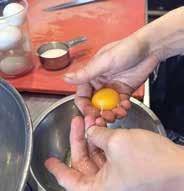

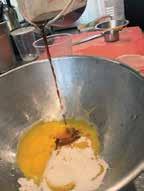


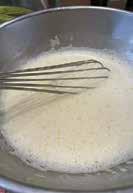

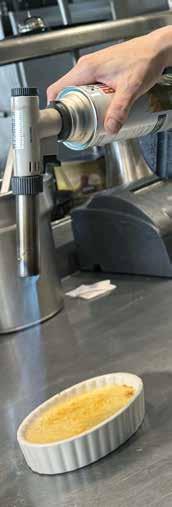
5. Distribute cooked corn evenly among ramekins. 6. Carefully separate egg yolks, saving the whites for another use if desired. 7. Vanilla, sugar and egg yolks form the custard. 8. Whip yolk mixture until a pale yellow color emerges. Finished mixture is light and frothy. 9. strain cooked cream through a fine-mesh sieve. 10. Fill prepared ramekins with cream mixture. 11. Cook crème brulee in a roasting pan with a water bath. 12. a culinary torch can be used to remove bubbles before cooking. 13. Chapman uses a culinary torch to brulee the tops of his savory corn crème brulee. though Chapman is pictured using a culinary torch to finish his crème brulees, the same effect can be achieved in the oven, under the broiler.
PHotos BY allison Collins
While the cream rests, separate eggs and, using a mixer or whisk, beat yolks with sugar and vanilla until combined. “It forms a nice pale color,” Chapman noted. “It starts out kind of orange, but then you get this nice, beautiful yellow. And, much like I measure garlic, I measure vanilla with my heart; there is such a thing as too much vanilla, but I highly doubt anyone is going to find that point.”
Place the bowl with the egg mixture on a towel, to prevent slipping. Separately, strain cream through a fine-mesh sieve and into a pouring vessel. Then, while continuing to whip egg mixture, slowly pour warm cream into the eggs.
Make sure ramekins/the roasting pan are on a level surface and divide custard evenly into ramekins. “Bubbles are not harmful, they just don’t look good, so a trick I learned is to take your culinary torch and just go over it real quick,” Chapman said. “It’ll take all the bubble out.”
Create a water bath by pouring hot water into the roasting pan, avoiding the custard in the ramekins. “There’s many ways people say to make water baths,” Chapman said. “I like to put (the pan with the
ramekins) in the oven, then add the water. Gently pour the water in, and you’re just aiming for halfway up (the pan edge).”
Cook at 300 for 50 minutes. “Once it’s in the oven … you can open the oven if you want, peer through the door, turn the light on, but it’s going to be 50 minutes,” Chapman said. “Check it at 45 if you’re nervous. It should have enough set at the edges, but still have a little jiggle in the middle.
“I recommend you let it cool in the water bath for half an hour, or until you can touch them, because they are hot, then remove and let cool for about two hours.”
Once ready, top crème brulees with sugar and lightly torch or broil the tops in the oven until sugar caramelizes and forms a crust. To “brulee” a dish means to burn the top until brown.
Chapman noted: “It is 50 minutes in the oven, with about two hours of prep time, but a lot of that is hands-off. And absolutely you can set all this up ahead of time, like the night before, which is what I usually do. I think it ends up better if you set it up the night before and let the crème brulee sit and cool before you cook it.”
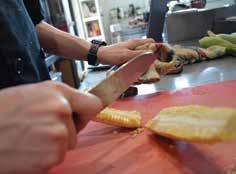



1. Use care when slicing through the cob vertically. 2. Once cob is halved, quarter vertically. 3. each ear of corn should yield four ‘ribs.’ lightly coat corn ribs with oil and season with salt and pepper. 4. Cook corn ribs, either in a cast-iron skillet on the stovetop or over a grill or under a broiler, until they blister and curl. Finish corn ribs with toppings of choice.
Chapman’s corn ribs, like his savory crème brulee, take a summertime staple and present it in a way that feels fresh.
“It’s just cooked corn, bro,” he said, laughing. “It’s a fairly newish thing that people are doing lately, and just a cool way to do corn on the cob. Presentation-wise, it looks really cool and, flavor-wise, because of how it cooks. They’re called ribs because you keep the rib; it is odd-looking and sort of weird and goofy, but aren’t we all?”
4 to 6 ears of corn
Butter or olive oil, for cooking and serving Salt and pepper
Toppings of choice, see below
“I always like to make a flavored butter with it,” Chapman said. “Corn and butter are synonymous with summer and barbecues in New York State. My personal favorite is garlic butter; it goes well with anything. Honey butter is always a good one. I like Tajin; that just works with the corn if you want to go for an elote vibe, and that’s really easy. Chipotle is another one of my favorite sauces to do with it – a chipotle, adobo blend, with mayo. Or breadcrumbs, again for a more elote style, or breadcrumbs and parmesan.”
Cut ends from each ear of corn, creating a flat surface. Holding the cob vertically, slice down and through the entire cob. Chapman suggests holding the cob with a towel for added stability during this step.
“I will fully admit, you have to use a very sharp knife,” he said. “Please, please use a sharp knife, and keep your fingers out of the way. Even with all my experience, I get a little scared when I do this.”
Once cobs have been halved, quarter them and rub lightly with oil, then season with salt and pepper.
“This is where we get into variations of cooking,” Chapman said. “We don’t have a grill here (at the bside), but that is my preferred method. On the grill, I’d have it on high then take my prepared corn ribs (and place over grill rack). If you don’t have access to a grill, this is pretty easily done on a stovetop, in a cast-iron pan, over real high heat until the corn starts to blister. You could do it under a broiler if you want, for five minutes. What you’re looking for is the corn to blister and curl.” Once corn “ribs” have curled, remove from heat and season with desired toppings. +

Corn ribs are pictured with chipotle mayo and a topping of garlic butter, breadcrumbs, parmesan cheese and sliced scallions.
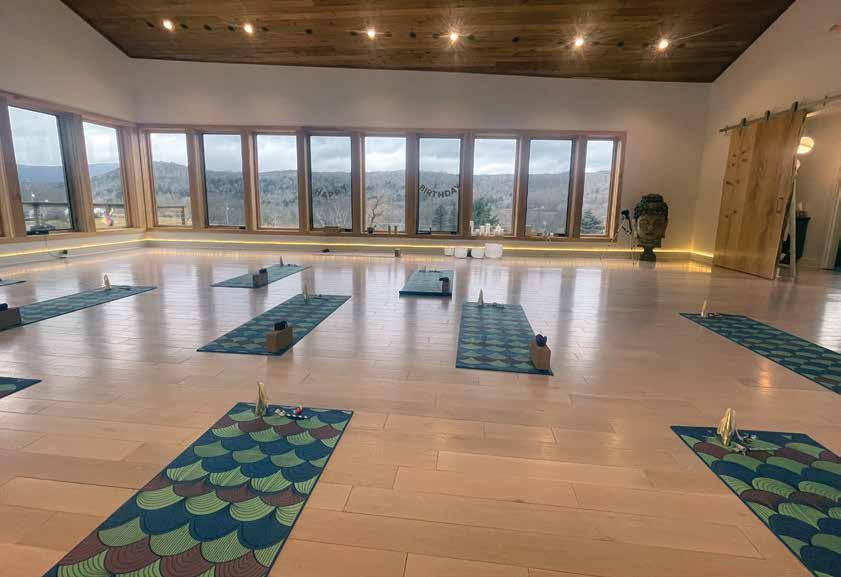

This month, I sat down with Terri Speck, co-founder of Peace, Love and Yoga (PLaY) in Roxbury to hear about their studio and community offerings, and to find out what summer wellness tips she has to share. No surprise there, she recommends yoga!
BY CHELSEA FRISBEE JOHNSON
Tell me about PlaY (Peace, love and Yoga) and the programs/offerings you have for the community.
When we conceptualized PLaY, we imagined a space that reflected all the current trends in promoting a healthy and flourishing life. We imagined bringing in people from all different practices and having them share their particular specialty. We like nothing better than when someone brings in their own particular magic to share with our community. I’m planning a wellness pop-up, perhaps in the fall, and I want to include people in chiropractic, acupuncture, massage, aromatherapy and all different specialties. The path to wellness isn’t one-size-fits-all, and we want to create a space where everyone can have a taste and find what works best for them.
I’m taking advanced training called “Empowered Relief.” It’s offered out of Stanford University and it’s training to deliver their chronic pain relief program. I’m so excited to be able to offer this to our community; chronic pain can be so debilitating!
I’m also taking a year-long program out of Spirit Rock Meditation Center in California. The program will help me to integrate more deeply the teaching of yoga into the practice of yoga. There’s so much wisdom about living a life with ease in the yoga tradition; I’m excited to be able to share that more effectively at the end of my training.
We’ve also started offering yoga getaways (and) they are super fun. We are collaborating in August with one of our yoga instruc-
tor friends, Jennifer Kessler. She’s a fabulous teacher. In addition to great yoga classes, we get to do fun things like hike and kayak. So, it really is a reset for people.
We’re also going to be offering yoga on the top of Belleayre Mountain every Sunday through the summer. We’re really excited about that, because it can be such a fun practice.
We had a lot of fun with the name of the studio. The name is a bit of a rift on the movie “Peace Love and Woodstock.” But we also love it because we use the acronym “PLaY.” We feel that’s one of the things that we want to encourage people to do more of.
PLaY is one of the forms of flourishing, and it’s so important for a satisfying life. My own style of yoga is a little bit more playful and I tend to include some popular music. It means the world to me when someone leaves feeling a little bit lighter.
What impact do you see PlaY having on the community?
Our goal from the very beginning was to be more than just a yoga studio. We hope to be one of the cogs in that beautiful wheel in Delaware County of people offering all sorts of vital ingredients to living a healthy and long life. We fill the studio with art and music and our message has always been one of acceptance. We hope to continue to widen the sphere of our offerings so that everyone feels that there’s something here for them.


What are the Top 3 wellness practices that you recommend to clients at this time of year?
Well, that’s a great question but also an easy one for me to answer! Number one: Get some kind of exercise (yoga would be great). Number two: Get outdoors. Number three: Eat as simply as possible. Fortunately, in the Catskills, it’s really easy to live that very healthy lifestyle.
What’s your own personal favorite self-care practice during the summer months?
My favorite self-care practices in the summer months are hiking with family and friends, yoga, and gardening. One of our favorite things to do on a Sunday afternoon is pick a new location –maybe a farmers’ market or granary or a fruit press – and we’ll just drive there and explore. There are so many hidden gems in our area and we haven’t even scratched the surface.
The thing that most inspires me about my work is my deep belief in the possibility that people’s lives can be improved by embracing these practices and making even the smallest changes. I also feel for me, personally, developing this community has enriched my life and I want to share that with everyone. One of the most beautiful things I see at PLaY is when someone enters for the first time and the other yogis in the classroom always make a point to say hello and introduce themselves. I honestly get tears in my eyes; the generosity and that welcoming spirit is so magical to me.
Our biggest challenge is that it’s very hard as a solo business owner to deliver all the care and classes that we would like for our community. We’re always looking for teachers who want to come in and help us grow our practice, but … we are a tiny little community and change happens slowly.
People can go to our website, playcatskills.com. It’s filled with information about upcoming events and special offerings. Our schedule of our classes is available, or one can learn about our instructors as well. We have a pretty strong presence on social media (Instagram and Facebook: @playcatskills), and that’s a great way to follow us and experience the spirit of PLaY. +


find more joy and
in their life.
is
last
Corner column. let us know if you would like to write a similar column for upstate life magazine.






















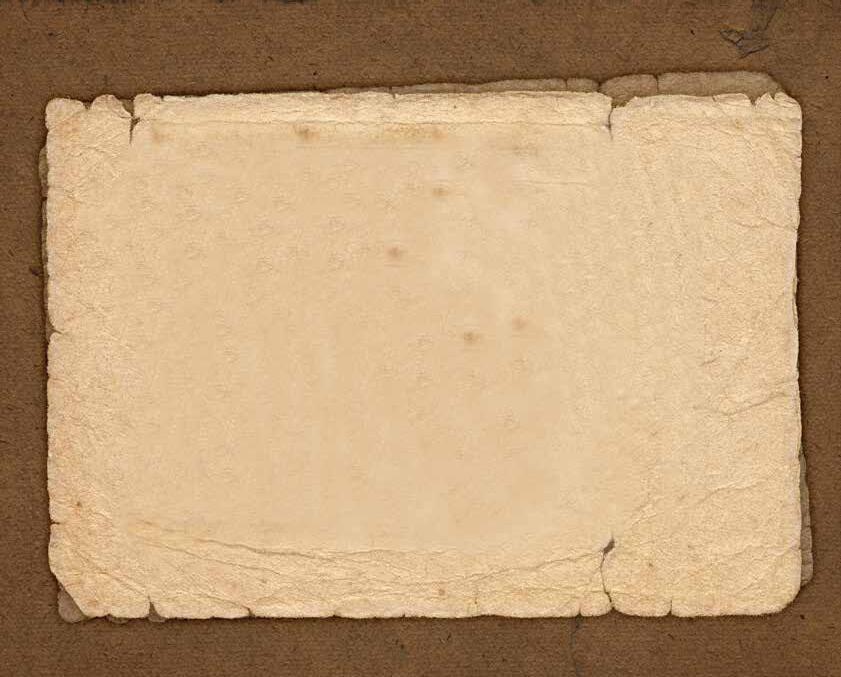

Even 140 years ago, many embraced the summertime mindset of “getting away from it all,” especially those from the New York City area, where the heat was oppressive for several months, with filthy air and no air conditioning. Many looked forward to getting away to the Catskill Mountains, where temperatures were typically 15 degrees cooler and the air and views fresher.
Stamford became a destination in the 1880s, and was considered by many to be the “Queen of the Catskills.”

BY MARk SIMONSON
Year after year, visitors would come by train and, later, by automobile, bus or even the Hudson River Dayline to Kingston. Some would come for a short vacation, others for the full season. Wealthy families from Cuba and Latin America visited regularly. The Catskills, and specifically Stamford, meant one thing to a vacationer: rest, superb food and drink, recreation and fun.
Dr. Stephen E. Churchill is credited with turning little Stamford into a world-class resort town. When Churchill learned the Ulster and Delaware Railroad was extending passenger service to the region, his intuition was to develop Stamford and bring other local entities onboard.
Churchill Hall was the first of the grand hotels, opening July 4, 1883 and located on Main Street, with four buildings boasting modern conveniences. Churchill advertised in New York City newspapers the winter before and was sold out for the season from opening day.
Between 1890 and 1893, 12 other hotels were built in Stamford and, by 1905, there were 32. The economy thrived on tourism.
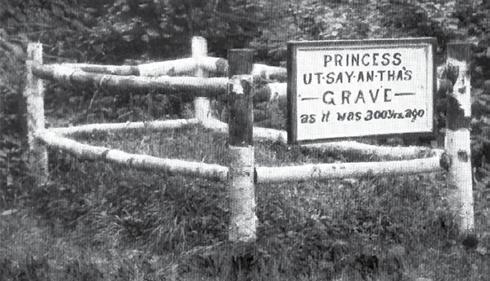
As a tourist or boarder, guests would see bright lights illuminating the hotels at night. The brightness would extend into the streets, giving a feeling of grandeur, welcome and protection from the night’s darkness. One might take a stroll along well-lit Main Street or take to a comfy chair on the porches after dinner, before the evening’s entertainment. Charity balls, musicals, opera, fashionable pink teas, card game parties, croquet and tennis tournaments were among the offerings of an evening. Not far away, there were athletic grounds, with a baseball diamond, a track for bicycling and horseback riding.
In 1882, Col. Rulif Ruliffson constructed a road to the top of Mount Utsayantha. A must-visit spot for tourists, it was officially opened to the public July 4, 1882. It was originally called Mount Prospect. Geographically, it was a mid-point between the Atlantic Ocean and the eastern shores of Lake Ontario. Viewers would never be able to see that far both ways, but they settled for the Berkshires, Green Mountains and other Catskill peaks, and weren’t disappointed. The Kingston Freeman reported Rulifson expended $1,000 for the clearing and building of a tower.
Mount Utsayantha got its name from the legend of a local Native American maiden, Utsayantha. It’s not a happy story, though. She was said to have had a child whose father was white. It made Utsayantha’s father – a chief – furious. So much so that he killed the white man, and rowed a boat with the baby to the center of a local lake and drowned it. Utsayantha, in her despair, proceeded to drown herself in the same lake. The chief then carried her body up the mountain, where he buried her. The granite grave marker can be seen today, where the alleged burial spot is located.
Dr. Churchill became a later owner of the mountain. In 1910, he installed a searchlight that reportedly could be seen for 20 miles and helped early airplane pilots navigate. When Churchill died, he willed the top of Mount Utsayantha to the village of Stamford. The mountaintop was also the site of a Civilian Conservation Corps project in 1934. A 68-foot observation tower was constructed for $260. Numerous fires were spotted from this tower, from the days Alton Henderson became the first observer until the tower’s closure in 1989.



On the western end of the village, Dr. Churchill had some land cleared in 1884, and beautified it into a park. Four lakes were built on a stream running through it. A fine place to stroll, or boat, on the lakes: Lochs Helen, Vesta, Alice and Marion, named after his nieces.
Near here, Churchill built the Rexmere Hotel in 1898, which served as a grand hotel until 1955. The Rexmere was destroyed by a fire in 2014.
For some of the early years of Stamford’s era as a resort town, it had a celebrity in its midst and a native of the village. Edward Zane Carroll Judson was no “papa’s boy.” Born in 1823, Judson grew up in Stamford. His father was a preacher, and the job took the family to Pennsylvania when Edward was eight. Mr. Judson wanted Edward to become a highly educated man, but Edward had other ideas. Apparently, Mr. Judson was a bit overwhelming to Edward, so by age 12 he ran away from home. Travel and writing were the things Edward Judson wanted to pursue. One of his first travels was on a freighter into the Caribbean, as a cabin boy. He later became a midshipman under General Zachary Taylor at 15, and was involved in the Seminole War in Florida. Judson then traveled west.
Edward Judson loved to write about his travel and adventures. He was also a very good storyteller. Judson took on a pen name that reflected on his days of sailing: Ned Buntline. The last name was chosen as a reminder of a rope at the bottom of a square sail. Buntline saw and did a lot in his years as a sailor, newspaperman or being out on the western frontier. Buntline retired to Stamford in 1873. He designed and built his home, the “Eagle’s Nest,” found today at 1 Buntline Drive. Here, he spent time reading, writing and “gentleman farming.” Buntline was a familiar sight in the village of Stamford during those years. Buntline continued to

write, until he died in 1887 at 64. He is buried in the Stamford Rural Cemetery.
As Stamford flourished, passenger train service increased. There were even “husband trains” for Saturday nights, where the man would join his vacationing family for the weekend, then return to the city on an early Monday morning run.
The grand era of hotels in Stamford ended with World War II. The last passenger train passed through the village in 1954. +
Historian Mark Simonson grew up in Oneonta. He has worked in public relations, marketing and broadcast journalism. Simonson was appointed Oneonta City Historian in 1998. He writes a historical column in The Daily Star and has published books highlighting local and regional history.
Here, Simonson shares stories about old buildings of interest in the upstate region.

“I hope you enjoy reading Bookmarked with Ash.”
Ashley Weeden

by Emily henry
imagebyFreepik
If you are craving a hilarious and jovial read this summer, no one delivers a vacation rom-com quite like Emily Henry. Happy Place takes readers on a trip to Maine, where a group of friends meets every summer for a week-long vacation. Though it is certainly a book about close friendships and introspection, it mostly centers around the love story, and breakup, of Harriet and Wyn.
Despite being broken up for months at the time of the vacation, Harriet and Wyn have not told their friends or families. They pretend to still be happily together, just for the week, to avoid ruining the traditions and festivities for their friends. They discover it is easier said than done, as they navigate the week with comically awkward and tense situations. It is immediately apparent they both harbor unresolved feelings for each other, which is entertaining as often as it is a poignant reminder of breakup woes.
Henry has a gift for making the reader laugh out loud in the first chapter, then feeling the tug of emotion in the next. She presents a slew of delightful and amusing characters, each with their own story and unique relationship dynamic. The chapters bounce back and forth between the current vacation, past vacations and memories of Harriet and Wyn falling in love and falling apart. Harriet and Wyn have magical chemistry throughout the entire story and are just as lovable separately as they are together; readers can’t help but root for their happy ending. Whether you are relaxing on the beach or lounging on your couch, Happy Place is certain to take you to a happy place.

by Abbi Waxman
There is something remarkable about a book that can capture heavy, real-life emotions in a heartfelt and tactfully comedic way.
Lilian is grieving the loss of her husband, who unexpectedly passed a few years ago. Even with help from her exceptionally supportive sister, Rachel, Lilian is still struggling to navigate life without him. As part of her job as a textbook illustrator, Lilian’s boss signs her up for a gardening class to prepare for an important project. She attends the class with her two young daughters, Annabel and Clare, and Rachel. Together they discover a healing world of soil, plants, worms and unexpected friendship. As Lilian learns to tend the garden, she begins tending her own heart.
Waxman presents any type of reader with a story that powerfully blends loss, love and hope. She delicately portrays Lilan’s grief journey with consideration and authenticity. Lilian and Rachel share a tender and refreshing sisterly bond, as Rachel steps in to help Lilian care for Annabel and Clare. The gardening class provides an eclectic set of characters and captures the impact of human connection and humor, especially in times of loss.

Waxman delivers impressively funny puns throughout the entire novel. The addition of blurbs before each chapter dedicated to gardening tips and quips is unique and enjoyable, making it the perfect read for an uplifting summer treat.













Advertising & Media (Publishers, Public Relations, Marketing)
The Cooperstown Crier 102 Chestnut St., Oneonta, NY 607-432-1000 coopercrier.com
The Daily Star
102 Chestnut St., Oneonta, NY 607-432-1000 thedailystar.com
Auto, Motorcycle & Campers
(Automobile Dealers, Auto Body & Painting, Auto Clubs, more...)

Oliver’s Campers Inc. 6460 State Hwy. 12, Norwich, NY 607-334-3400 •oliverscampers.com
Construction & Building Services
(General Contractors, Construction, Engineers, Architects)

Gilbert Plumbing & Heating P.O. Box 96, Gilbertsville, NY 607-783-2289 • www.gilbertph.com

Home Foam Insulation Denver, NY • 845-594-7413 www.homefoaminsulation.net
Construction & Building Services
(General Contractors, Construction, Engineers, Architects)
Drilling Corp.
Titan Drilling Corp.
264 Co. Hwy. 38, Arkville, NY 1-800-GO-TITAN • 1-845-586-4000 titanwelldrillingny.com
Home & Garden (Home & Garden, RemodelingBath & Kitchen)


Tweedie Construction Services, Inc. 90 Crystal Creek Rd., Walton, NY 607-865-4916 • 607-865-4913
(Arts, Entertainment, Recreation, Travel, Events, Museums)
ASSOCIATION GALLERIES
22 Main St., Cooperstown, NY 607-547-9777 • cooperstownart.com


Iroquois Indian Museum 324 Caverns Rd., Howes Cave, NY iroquoismuseum.org
3746 St. Hwy. 23, Oneonta, NY 607-432-2400 • hillsidekennels.com

Homestead Pet & Farm Supply 3 Railroad St., New Berlin, NY 607-847-6173 Like us on Facebook Farm and Pet Care (Boarding, Supplies, Wellness, more...)

Finance & Insurance (Banks, Financial Advisors, Insurance)
Bieritz Insurance Ben Novellano 209 Main St., Cooperstown, NY 607-547-2952 • 607-263-5170 (Morris) bieritzinsurance.com

purecatskills.com

ServiceMASTER by Burch 607-988-2516 servicemasterbyburch/com

Blenheim-Gilboa Visitors Center
1378 State Rt. 30, North Blenheim, NY 1-800-724-0309 nypa.gov/BGVisitorsCenter








